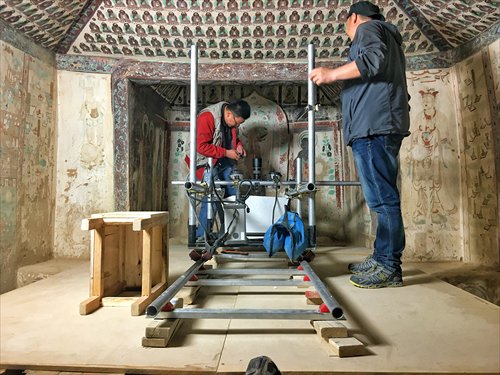
Staff scan a mural in the Mogao Caves in Gansu Province on May 31. (Photo: Li Jingjing/GT)
The digital version of Mogao Caves, e-dunhuang.com, became an almost immediate hit in the field of cultural relic preservation after it officially went online in May. Through the site, anyone from around the world can view 360 degree panoramas of the caves as they virtually navigate around in high resolution without actually setting foot in the caves.
"Before it was like something hidden in a house. Our problem was how we could get people to pay attention to the caves and understand them if they can't see them?" the director of the Dunhuang Academy, Wang Xudong told the Global Times.
E-Dunhuang is great for tourists who can't travel all the way to Gansu Province in Northwest China to see the caves, but Wang hopes the convenient access will also inspire Dunhuang researchers and artists.
Among the 735 caves of the 1,000-year-old Mogao Caves, 492 have murals, all of which possess substantial artistic, historical and religious value.
Currently 30 caves are available online, with more caves coming as digital scanning continues.
However, the process of digitization is not an easy one.
Major hurdles
"There are many things we have to consider when taking scans, such as what kind of equipment and lighting are needed. Each cave is different from each other," Yu Shengji, the digitization project's field director.
Each cave is different in size and shape, which adds considerable difficulty to the digitization process. Yu has to consider how to find the right angles for the cameras so they can take the most precise images of the murals without damaging them.
The team divide murals into horizontal lines, which are then scanned one at a time. Fifty percent of each line overlaps the one that proceeded it. The team then chooses which overlapping section is of higher quality during post-production to make sure every picture they take is as clear and precise as possible.
Wang said the Dunhuang Academy first started digitalizing the caves in the 1990s, a plan initiated by the director at the time Fan Jinshi. However, the technology they used back then posed serious challenges.
Digitization was very difficult for them at first, but through collaboration with international organizations, such as The Andrew W. Mellon Foundation and Northwest and Illinois universities in the US, they were able to come up with solutions to their technological and funding problems.
It wasn't long before the academy had cultivated a team that could handle everything on their own.
Through their efforts during the 1990s, they discovered that color fidelity and geometrical deformation were two main problems that had to be dealt with during the digitization process.
"Without those early efforts in the 1990s, we wouldn't have known how to handle things when we got hold of new technology," Wang told the Global Times.
High technology
Beyond digitization, new technologies are also playing a more direct role in preserving the caves.
Monitoring equipment has been installed in each cave to track the temperature and humidity inside caves. The doors to each cave remain shut until visitors come in. On rainy days, most cave entrances remain closed for protection purposes.
These protections are in place because any break in the balance of humidity, carbon dioxide and microbes can damage the murals.
"Through careful monitoring and other technological means we keep these potentially damaging influences under control," Wang said.
"We also try to reduce the time visitors spend inside the caves and reduce the number of caves open to the public."
To better protect the caves and enhance visitor experience, the Dunhuang Academy has limited the daily number of visitors to 6,000 for the past several years. Additionally, visitors can book tickets online with an ID in advance.
To keep better inform visitors and keep them entertained while waiting their turn to tour the caves, a digital hall was introduced last year. Before entering the caves, visitors are shown two short films, one about the history of the Mogao Caves and another a 360 degree panorama tour of the caves.
Although tickets are also available at the gate for those who don't book online, these are only for sale every other day, they do not include the two films and visitors only get to see four caves. Wang said he hopes these limitations will encourage visitors to book online in advance.
Bringing people together
"What we lack the most is people, not money," Wang told the Global Times.
With support from the government, funding is no longer a problem for the Dunhuang Academy. However, the academy is always looking to collaborate with experts in all types of fields, artists and organizations from around the globe to study and protect the Mogao Caves together.
Wang said they are currently collaborating with organizations from Italy, Japan, France and the UK.
A thousand years ago, Dunhuang was a place where different cultures, religions and people co-existed and interacted with each other. Wang said he believes this fact should be a source of inspiration to people today.
"If we could live and co-exist here a thousand years ago, why can't we understand each other now?" Wang said.
"I believe Dunhuang will once again be a cultural hub in 1,000 years."


















































